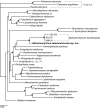Batrachochytrium salamandrivorans sp. nov. causes lethal chytridiomycosis in amphibians
- PMID: 24003137
- PMCID: PMC3780879
- DOI: 10.1073/pnas.1307356110
Batrachochytrium salamandrivorans sp. nov. causes lethal chytridiomycosis in amphibians
Abstract
The current biodiversity crisis encompasses a sixth mass extinction event affecting the entire class of amphibians. The infectious disease chytridiomycosis is considered one of the major drivers of global amphibian population decline and extinction and is thought to be caused by a single species of aquatic fungus, Batrachochytrium dendrobatidis. However, several amphibian population declines remain unexplained, among them a steep decrease in fire salamander populations (Salamandra salamandra) that has brought this species to the edge of local extinction. Here we isolated and characterized a unique chytrid fungus, Batrachochytrium salamandrivorans sp. nov., from this salamander population. This chytrid causes erosive skin disease and rapid mortality in experimentally infected fire salamanders and was present in skin lesions of salamanders found dead during the decline event. Together with the closely related B. dendrobatidis, this taxon forms a well-supported chytridiomycete clade, adapted to vertebrate hosts and highly pathogenic to amphibians. However, the lower thermal growth preference of B. salamandrivorans, compared with B. dendrobatidis, and resistance of midwife toads (Alytes obstetricans) to experimental infection with B. salamandrivorans suggest differential niche occupation of the two chytrid fungi.
Keywords: amphibian decline; ecosystem health; emerging infectious disease.
Conflict of interest statement
The authors declare no conflict of interest.
Figures




References
-
- Mendelson JR, III, et al. Biodiversity. Confronting amphibian declines and extinctions. Science. 2006;313(5783):48. - PubMed
-
- Caruso NM, Lips KR. Truly enigmatic declines in terrestrial salamander populations in Great Smoky Mountains National Park. Divers Distrib. 2013;19(1):38–48.
-
- Spitzen-van der Sluijs A, et al. Enigmatic decline drives Salamandra salamandra to the edge of extinction in The Netherlands. Amphib-reptil. 2013;34(2):233–239.
Publication types
MeSH terms
Substances
Associated data
- Actions
- Actions
- Actions
LinkOut - more resources
Full Text Sources
Other Literature Sources
Molecular Biology Databases

